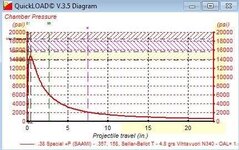- Messages
- 1,410
- Reactions
- 707
On <broken link removed> , N340 is #37 and AA#5 is in 41 place. Does not seem much of a difference. But even techiej data shows how much slower AA#5 is.
Normally same load data can be used for both revolver and rifle. You'll just get different muzzle velocities and amount of powder burnt inside/outside the barrel. Exceptions happen when either rifle/carbine or handgun take higher pressure loads than the other. Usually happens on older calibers with older v. modern mfg guns. Example 45/70 govt.
You want most of the powder burnt inside the barrel to obtain the most internal ballistic efficiency. Fast powders will tend to burn completely inside barrels, even on the shorter ones (handgun). Often, the bullets has not traveled much inside the barrel before the powder is totally burnt.
Now, let's take what I call one extreme combo: a very fast powder on a very long barrel. A small amount of fast powder burns right away, just 1-3 inches after bullet separates from case. Bullet still must travel ~20 in on that long carbine barrel solely on gas expansion generated on the first couple of inches. But as the bullet progresses, the pressure inside the barrel drops significantly as no new powder gets burnt to maintain pressure inside the barrel. Bullet accelerates but tappers of as it moves down the barrel. Take this to the extreme. For a barrel long enough it is possible to have a bullet decelerate (slow down) inside a barrel when the gas pressure inside the barrel gets so low it can't overcome bullet/barrel friction. Hence, muzzle velocity can be slower in a barrel that is too long, or a powder that is too fast. Take it to the next extreme and you get a stuck bullet.
One side effect of using fast powders is maximum pressure can be obtained with a smaller amount of powder than slower powders, limiting sometimes the maximum muzzle velocity you can obtain from a given bullet, especially, true the heavier the bullet/ longer barrel length combination.
The chart for N340 below shows all powder is burnt by the time the bullet reaches 7.5in (purple line). (158gr bullet in a 24in bbl)

Now, take slow powders. One thing you will notice is that the slower the powder, the more powder you will need to obtain the same muzzle velocities. That's is no coincidence. The slower the powder the longer it will take to completely burn inside the barrel. Acceleration does not tapper off as quickly because powder keeps burning as the bullet moves down the barrel because internal pressure does not tapper off as quickly, and the longer the expanding gases will be pushing that bullet thru the barrel. The chart for AA#5 below shows powder is 95% burnt by ~20 inches(green line). (158gr bullet in a 24in bbl)

This is the main reason why magnum calibers all use slower powders. In handgun magnum powders you tend to fill the case up completely, you get ~ 70-90% powder burns, and impressive muzzle flashes.


Normally same load data can be used for both revolver and rifle. You'll just get different muzzle velocities and amount of powder burnt inside/outside the barrel. Exceptions happen when either rifle/carbine or handgun take higher pressure loads than the other. Usually happens on older calibers with older v. modern mfg guns. Example 45/70 govt.
You want most of the powder burnt inside the barrel to obtain the most internal ballistic efficiency. Fast powders will tend to burn completely inside barrels, even on the shorter ones (handgun). Often, the bullets has not traveled much inside the barrel before the powder is totally burnt.
Now, let's take what I call one extreme combo: a very fast powder on a very long barrel. A small amount of fast powder burns right away, just 1-3 inches after bullet separates from case. Bullet still must travel ~20 in on that long carbine barrel solely on gas expansion generated on the first couple of inches. But as the bullet progresses, the pressure inside the barrel drops significantly as no new powder gets burnt to maintain pressure inside the barrel. Bullet accelerates but tappers of as it moves down the barrel. Take this to the extreme. For a barrel long enough it is possible to have a bullet decelerate (slow down) inside a barrel when the gas pressure inside the barrel gets so low it can't overcome bullet/barrel friction. Hence, muzzle velocity can be slower in a barrel that is too long, or a powder that is too fast. Take it to the next extreme and you get a stuck bullet.
One side effect of using fast powders is maximum pressure can be obtained with a smaller amount of powder than slower powders, limiting sometimes the maximum muzzle velocity you can obtain from a given bullet, especially, true the heavier the bullet/ longer barrel length combination.
The chart for N340 below shows all powder is burnt by the time the bullet reaches 7.5in (purple line). (158gr bullet in a 24in bbl)

Now, take slow powders. One thing you will notice is that the slower the powder, the more powder you will need to obtain the same muzzle velocities. That's is no coincidence. The slower the powder the longer it will take to completely burn inside the barrel. Acceleration does not tapper off as quickly because powder keeps burning as the bullet moves down the barrel because internal pressure does not tapper off as quickly, and the longer the expanding gases will be pushing that bullet thru the barrel. The chart for AA#5 below shows powder is 95% burnt by ~20 inches(green line). (158gr bullet in a 24in bbl)

This is the main reason why magnum calibers all use slower powders. In handgun magnum powders you tend to fill the case up completely, you get ~ 70-90% powder burns, and impressive muzzle flashes.













